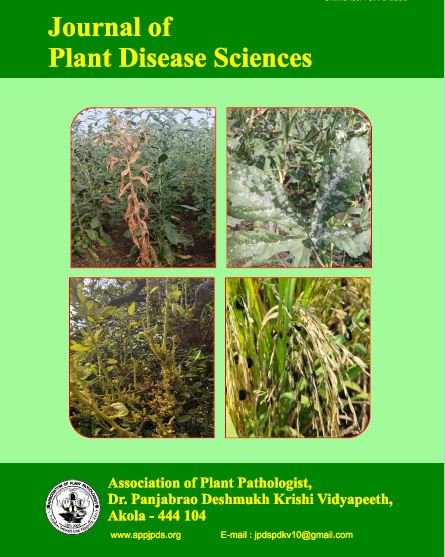PHYSIOLOGICAL CHARACTERISTICS OF ASSOCIATED WITH SAPOTA LEAF SPOT NEOPESTALOTIOPSIS PROTEARUM
DOI:
https://doi.org/10.48165/jpds.2024.19.02.01Keywords:
Leaf spot, Neopestalotiopsis protearum, Physiological studies, SapotaAbstract
Characteristics leaf spot disease specimens were collected from a sapota orchard on the university campus and brought to the laboratory, where pathogens isolated using the hyphal tip method and pathogenicity was successfully demonstrated in pot cultures. Neopestalotiopsis protearum was identified as the isolate based on symptoms, cultural, morphological, pathogenicity testing, and molecular analysis. The current study was undertaken to explore the effect of temperature, relative humidity, light, effect and pH level on the growth development and sporulation of N. protearum, the cause of Sapota leaf spot. N. protearum exhibited maximum growth and sporulation at 30°C, with 25°C being the next best temperature. Both 20°C and 35°C exhibited similar impacts on mycelia growth, although 20°C produced more spores. The least growth was observed at 15°C and 40°C. The fungus thrived at 95 percent relative humidity, while 90% also supported good growth. A 12-hour light/dark cycle was ideal for growth, while continuous darkness also aided growth, however, continuous light impeded growth. The fungusfavored a pH of 7.0, but a pHof 6.5 also supporting good growth. Overall, the ideal conditions for N. protearum are 30°C, high humidity(>85%), a 12-hour light/dark cycle, anda pHof 7.0.References
Anonymous, 2021-22: Prodcution profile of sapota 2021-22. https://agriexchange.apeda.gov.in.
Adhikari, K., R. Anupamand S. Kailash, 2023: Invitro antagonism of Trichoderma isolates and efficacy of chemical fungicides against mycelial growth of Pestalotiopsis theae. J. Inst. Agric. Anim. Sci, 37:8- 18.
Arunakumara, K. T., C. Satyanarayana and N. Srinivas, 2014: Impact of abiotic and nutritional factors on the growth of Alternaria solani causing early blight of potato. Pest Management in Horticultural Ecosystems, 21(2):190-193.
Asalkar, U. A., D.G. Hingole, P. B. Khaire and V. S. Mete, 2019 : Effect of different solid media on the Colletotrichum gloeosporioides Penz. and Sacc. causing fruit rot at Aonla. Int. J. Curr. Microbiology App. Sci., 8(10): 610-616.
Carlile, M. J., 1965: The photobiology of fungi. Ann.
Rev. Plant Physiol, 16: 175-202.
Das, R., M. Chutia, K. Das and D. Jha, 2010: Factors affecting sporulation of Pestalotiopsis disseminata causing grey blight disease of Persea bombycina Kost. The primary food plant of muga silkworm. Crop Protection, 29:963-968.
Fovo, J. D., D. Dostaler and L. Bernier, 2017: Influence of culture media and temperature on growth and sporulation of Lasiodiplodia theobromae, Pestalotiopsis microspora and Fu s a r i u m o x y sp o r u m i s o l a t e d f r o m Ricinodendron heudelotii in Cameroon. Int. J. Curr. Microbiol. App. Sci, 6 (6):3098-3112.
Gerardo-Lugo, S. S. M. Juan, Tovar-Pedraza, Sajeewa
S. N. Maharachchikumbura, A. Miguel A. Apodaca- Sánchez, Kamila C. Correia, Carlos P. Sauceda- Acosta, Moisés Camacho-Tapia, Kevin D. Hyde, Najat Marraiki, Abdallah M. Elgorban and Hugo Beltran Pena, 2020: Characterization of Neopestalotiopsis species associated with mango grey leaf spot disease in Sinaloa, Mexico. Pathogens, 9: 788. https://doi.org/10.3390
/pathogens9100788
Hopkins, K. E. and M. Mcquilken, 2000: Characteristics of Pestalotiopsis associated with hardy ornamental plants in the UK. European Journalof Plant Pathology, 106:77-85.

